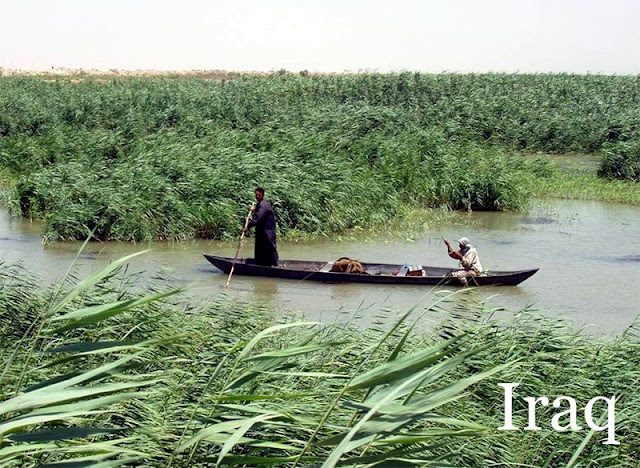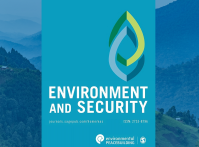-
Environmental Disaster or Impetus for Cooperation?
Iraq: Steve Lonergan on the Southern Marshes
September 21, 2010 By Schuyler NullIraq’s Southern Marshes, once the Middle East’s largest and most ecologically diverse wetlands, have survived the Iran-Iraq war, systematic drainage by Saddam Hussein, American invasion, and record-breaking drought. Today, however, the prospects for survival are dimming, as water consumption across the region continues to increase and security remains unsettled. Despite these challenges, the marshes’ location along the Iranian border and their reliance on flow from Turkey upstream offers unique potential for environmental peacemaking in this troubled region.
 Iraq’s population of approximately 31.5 million is predicted to balloon to 64 million by 2050, and today 41 percent of the population is under the age of 15. The vast majority of the 64 million will live along the Tigris or Euphrates. Both rivers drain into the Southern Marshes, which as recently as the 1980s provided 60 percent of Iraq’s fish. Today, the marshes are a fraction of their former size (see maps below), no longer provide appreciable sustenance at the national level, and support fewer than 10 percent of their original number of inhabitants.
Iraq’s population of approximately 31.5 million is predicted to balloon to 64 million by 2050, and today 41 percent of the population is under the age of 15. The vast majority of the 64 million will live along the Tigris or Euphrates. Both rivers drain into the Southern Marshes, which as recently as the 1980s provided 60 percent of Iraq’s fish. Today, the marshes are a fraction of their former size (see maps below), no longer provide appreciable sustenance at the national level, and support fewer than 10 percent of their original number of inhabitants.Although numbers are grim, much of the marsh habitat is highly resilient and could recover enough to support local livelihoods – but not without concerted water management efforts by the Iraqi government and agreements with both Iran and Turkey.
Considering their strategic location and great cultural importance (sometimes called the real-life “Garden of Eden”), restoring the marshes might entice Iraqi leaders and their neighbors to come to the table to discuss more long-standing water access issues in the region.
 Geographer Steve Lonergan of the University of Victoria is an expert on hydrology and resource management in the Middle East and headed up the Canada-Iraq Marshlands Initiative (CIMI), which worked in Iraq from October 2004 – March 2010. CIMI recently published both a comprehensive atlas of the Marshes and a report on their current state, “Managing for Change: The Present and Future State of the Marshes of Southern Iraq.”
Geographer Steve Lonergan of the University of Victoria is an expert on hydrology and resource management in the Middle East and headed up the Canada-Iraq Marshlands Initiative (CIMI), which worked in Iraq from October 2004 – March 2010. CIMI recently published both a comprehensive atlas of the Marshes and a report on their current state, “Managing for Change: The Present and Future State of the Marshes of Southern Iraq.”New Security Beat recently interviewed Lonergan about the Southern Marshes and their future prospects:
New Security Beat: The CIMI report states that climate change and rising demand will put a serious strain on the Southern Marshes and, if nothing is done, may even lead to their near total loss. What sort of mitigation and/or adaptation efforts are under way if any, and do you see a space for them in Iraq?
Steve Lonergan: Not much is being done at present, and certainly not with the present problem of governance, nationally. Iraq does not have a drought management strategy in place, and it refused to label the 2009 drought a disaster because of possible negative perceptions by the international community. There has been investment in infrastructure to support the remaining residents, and small desalination plants have been installed in seven or eight communities (with funding from Japan and UN Environment Programme).
After Saddam drained the marshes, most of the people left, moving either to cities or to refugee camps in Iran. Very few people have returned (according to our sources), due to security issues, environmental quality issues, and the lack of water. The present marsh population is estimated at 80,000 persons, but most of them are living on the edge of the marshes.
I would guess that the population within the marshes – that is, living on the high ground in villages inside the marshes – is not more than 5,000 persons. As a result, there is not much of a political voice for marsh residents. The United States, Canada, and Japan have all discontinued direct assistance. Organizations such as the UN Development Programme are frustrated with the lack of action at the national level. So mitigation and/or adaptation efforts are minimal. NSB: UNEP, UNDP, the United States, Japan, Italy, Canada, and ad hoc local efforts contributed to a remarkable comeback from 2003-2008, but recently water levels in the marshes have dropped once again. What are the most important short-term steps that have yet to be taken with respect to the marshes?
NSB: UNEP, UNDP, the United States, Japan, Italy, Canada, and ad hoc local efforts contributed to a remarkable comeback from 2003-2008, but recently water levels in the marshes have dropped once again. What are the most important short-term steps that have yet to be taken with respect to the marshes?SL: The most important step would be to reach agreements with Turkey and Iran. In the absence of these, it is difficult to imagine how the marshes could survive. The marshes must also be considered a high priority within Iraq and this is not the case at present.
One of the major drainage canals built by Saddam Hussein’s regime, the Main Outfall Drain (MOD), now diverts water south of Nassiriya into the Shat al Arab River. Experiments are underway to determine whether this water can be treated and diverted back to the marshes.
It is likely that water levels in the marshes will continue to fluctuate; in wet years they will go up, and in drought years they will go down. But much of the original Southern Marshes are now being used for agriculture and are unlikely to return to marsh.NSB: In the past the Southern Marshes have been used as a buffer against invasion, drained to force out inhabitants, and dammed to prevent drug trafficking and help monitor the border. How important do you see conservation efforts in the marshes to promoting dialogue and ultimately improving security with Iran and even Turkey?
SL: There has been some hope in the international community and with people living in the marshes that environmental diplomacy, through the Ramsar Convention, a possible World Heritage Site designation, and bilateral discussions initiated by the UN, could stimulate better dialogue that could eventually improve security within the Tigris and Euphrates basins. Unfortunately, this has not occurred.
Neither Turkey nor Iran care about the marshes. Turkey went so far as to say that if Iraq wasted water by letting it pass through to the marshes that they would not release more upstream on the Euphrates. Iran seems quite happy to sell water to Iraq (they sold water to Basrah in 2009) rather than let it drain into the Marshes.
The Ramsar Convention cannot compel parties to dialogue and UN efforts have been unsuccessful. Having said this, there are ongoing technical discussions between water engineers from Iraq and Iran over the Hawizeh Marsh dyke. But until the Iraqi government is established and the security situation in the country is reasonably stable, I see little hope for these technical discussions. NSB: As mentioned in the CIMI report, the marshes once provided 60 percent of the fish consumed in Iraq, and their drainage has not only affected the marshes themselves but also fisheries in the Persian Gulf. Do you think fish stocks can ever recover to the point of once again playing a large role in Iraq’s food supply?
NSB: As mentioned in the CIMI report, the marshes once provided 60 percent of the fish consumed in Iraq, and their drainage has not only affected the marshes themselves but also fisheries in the Persian Gulf. Do you think fish stocks can ever recover to the point of once again playing a large role in Iraq’s food supply?SL: It is unlikely that fish stocks will ever recover, at least not in terms of native species. Low-valued species such as catfish (which Iraqis will not eat) now dominate in many areas as water quality has deteriorated. Attempts to restore the Bunni population – the highest valued species – were completely unsuccessful. There is still fishing in the marshes, but in many cases it is with poison or dynamite.
We ran workshops throughout the region on best management practices in fishing, but there simply is not enough fish to feed the local population, let alone the rest of Iraq.NSB: Given the continuing poor security situation as well as political deadlock, have the prospects for the future health of the marshes changed in your mind?
SL: In our study, we looked at many scenarios, three of which are highlighted in the report. The basic problem is simply one of lack of water. Upstream withdrawals from Turkey and within Iraq have severely impeded the flow of water to the marshes. The recent building of a dyke by Iran along the border has reduced the flow of water to Hawizeh Marsh, the largest of the three areas that comprise the Southern Marsh system.
With competition for water increasing (both from Turkey and Iran and also from other sectors within Iraq), it is doubtful whether there will ever be enough water to replenish the marshes to the extent they were prior to 1990. Coupled with greater climate variability – evidenced by the severe drought in 2008-2009 – and the decreasing quality of most of the water remaining, I remain pessimistic about the future of the Southern Marshes and the people dependent on them.Sources: BBC, Canada-Iraq Marshlands Initiative, Guardian, IPS-Inter Press Service News, NPR, New Scientist, Population Reference Bureau, UN Environment Programme, University of Pennsylvania Press.
Photo Credit: “Marsh Arabs in a mashoof,” courtesy of Wikimedia Commons. Maps courtesy of the Canada-Iraq Marshlands Initiative.
 A Publication of the Stimson Center.
A Publication of the Stimson Center.











